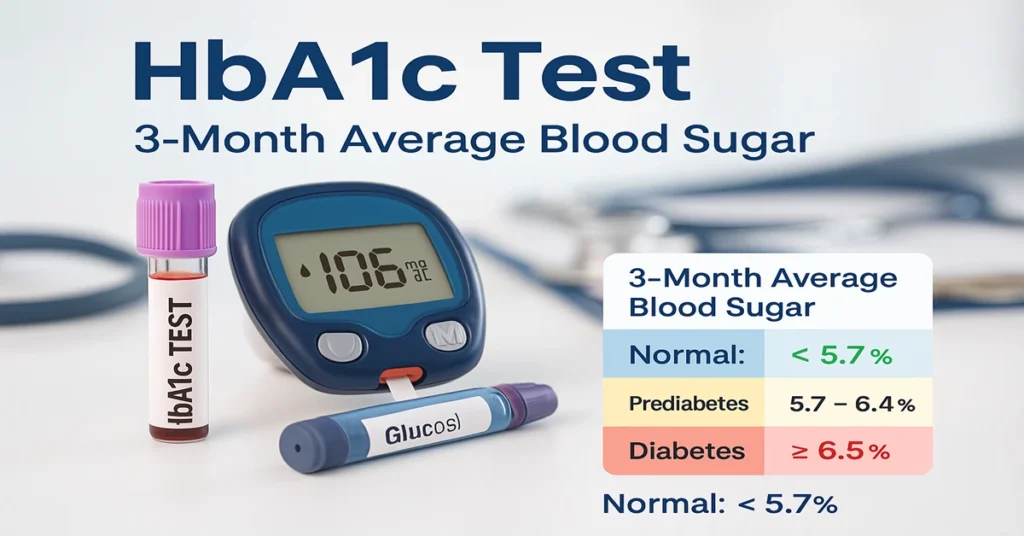What is HbA1c?
HbA1c stands for Hemoglobin A1c, also called glycated hemoglobin. It reflects the average blood sugar level over the past 2–3 months. When glucose (sugar) circulates in your blood, some of it attaches to hemoglobin inside red blood cells (RBCs). The higher the blood sugar, the more hemoglobin gets glycated.
Since red blood cells live for about 120 days, the HbA1c test gives a long-term picture of blood sugar control, unlike a random or fasting blood sugar test that shows only one point in time. Doctors use this test mainly to diagnose diabetes, prediabetes, and to monitor glucose control in diabetic patients.
Where is it Synthesized/Produced in the Body?
Hemoglobin is produced in the bone marrow inside developing red blood cells. Once glucose enters the bloodstream from food, it naturally binds to hemoglobin. This process is called glycation, and it happens continuously. The amount of glycated hemoglobin directly reflects your average blood sugar level.
Main Functions and Importance
The HbA1c test is important because it:
- Provides a 3-month average of blood glucose levels.
- Helps in the diagnosis of diabetes and prediabetes.
- Monitors long-term glucose control in diabetic patients.
- Shows how effective a treatment plan or lifestyle change has been.
- Avoids confusion caused by daily fluctuations in blood sugar (for example, after a heavy meal or exercise).
Causes of Low HbA1c
Low HbA1c is uncommon but may happen due to:
- Chronic low blood sugar (hypoglycemia)
- Excess use of insulin or anti-diabetic medicines
- Blood loss or recent blood transfusion
- Shortened red blood cell life span (e.g., hemolytic anemia)
Symptoms of Low HbA1c
Low HbA1c itself does not usually cause symptoms, but the underlying reasons may. If it happens due to over-medication, symptoms may include:
- Dizziness or confusion
- Sweating and tremors
- Feeling unusually hungry
- Rapid heartbeat (palpitations)
- Fainting or weakness
Causes of High HbA1c
High HbA1c usually means long-term high blood sugar. Common causes are:
- Poorly controlled diabetes (Type 1 or Type 2)
- High carbohydrate intake
- Missed insulin doses or incorrect medication use
- Sedentary lifestyle (lack of exercise)
- Chronic stress or ongoing infections
- Certain conditions like iron deficiency anemia
Symptoms of High HbA1c
High HbA1c often points to long-term hyperglycemia. Symptoms include:
- Feeling very thirsty (polydipsia)
- Frequent urination (polyuria)
- Blurred vision
- Constant fatigue or weakness
- Slow-healing cuts or wounds
- Numbness or tingling in hands and feet (nerve damage or neuropathy)
Reference Ranges
(may vary slightly by lab)
| HbA1c (%) | Interpretation |
|---|---|
| Below 5.7% | Normal (non-diabetic) |
| 5.7% – 6.4% | Prediabetes |
| 6.5% or above | Diabetes (confirmed) |
| Target for diabetics | Usually < 7% (doctor’s advice) |
This test helps not only in diagnosis but also in setting a treatment target for diabetic patients.
Sample Type
- Sample Type: Whole Blood
- Tube Used: Lavender-top EDTA tube
Test Preparation
- No fasting is needed. You can take this test any time of the day.
- Continue your normal diet before the test unless your doctor advises otherwise.
- Inform your doctor about any recent blood transfusion, as it may affect results.
- Tell your healthcare provider if you have anemia or blood disorders.
When to Consult a Doctor
You should see a doctor if:
- You have symptoms of diabetes such as frequent urination, thirst, or fatigue.
- Your HbA1c test result is above the normal range.
- You already have diabetes and your HbA1c stays above the target despite treatment.
- You are planning pregnancy and want to ensure safe sugar levels.
- You experience unexplained weight loss, blurred vision, or delayed wound healing.
Important Word Explanations
- HbA1c: Glycated hemoglobin, shows 3-month average sugar.
- Glycation: Process where sugar attaches to hemoglobin.
- Prediabetes: A stage before diabetes when sugar is higher than normal but not diabetic.
- Hyperglycemia: High blood sugar over time.
- Hypoglycemia: Low blood sugar that may cause dizziness or fainting.
- Neuropathy: Nerve damage caused by long-term high sugar levels.
~END~

